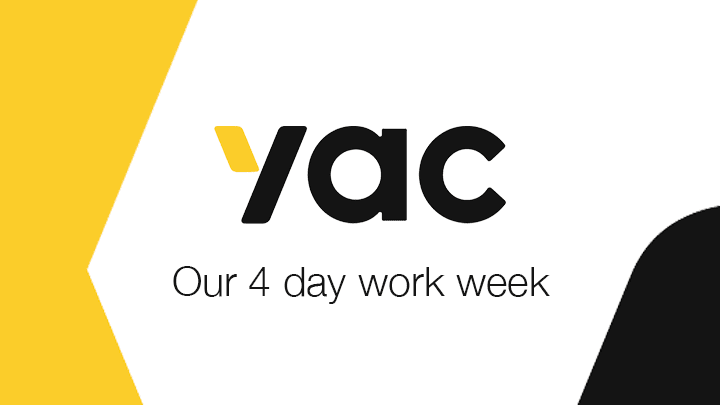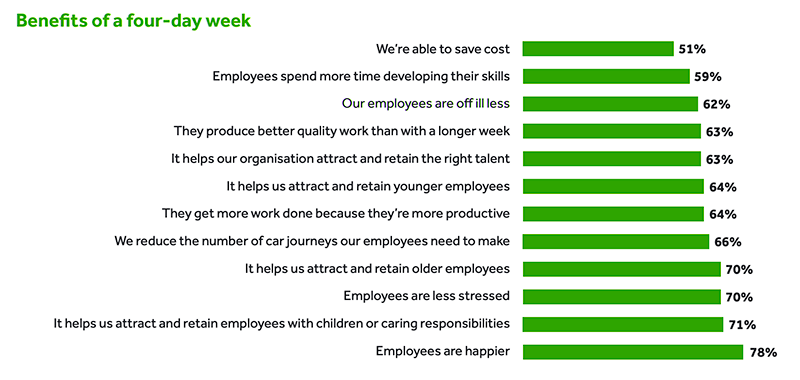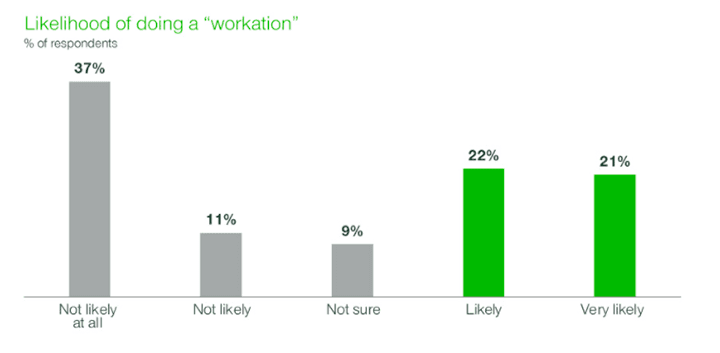How Yac Implemented a Four-day Work Week
The four-day work week has been a great success at Yac. From boosting productivity to empowering side hustles to preventing burnout, giving our team extra time back each week benefits both the company and our employees.

The new working norms created by the pandemic pose a conundrum for businesses. The flexible remote work model is now a highly sought-after benefit that supports employee wellbeing.
However, without collaboration and communication infrastructures, “working from home” can blur the line between tasks and downtime and lead to an "always on" attitude that results in employee burnout.
An alternative to a poorly-executed remote work model? Enter the four-day work week.
In one test case, Microsoft Japan saw a significant increase in productivity when they switched to a four-day week. And a study by Henley Business School shows significantly improved employee wellbeing. Companies that moved to a shorter work week found that 78% of employees were happier, 70% were less stressed, and 62% took fewer sick days.

Source: Henley Business School
The four-day work week has been a great success at Yac. From boosting productivity to empowering side hustles to preventing burnout, giving our team extra time back each week benefits both the company and our employees.
Here’s how we made it work.
Why Yac has chosen the four-day work week
For us, it's all about flexibility. We want employees to be able to work from anywhere as often as they need to work. Many of us are in different time zones, and while some business hours need to overlap with the team, the rest are asynchronous.
We began with the premise that you can only unlock a four-day work week when you start to reduce the number of tasks on your plate. And that starts with reducing meetings.
A lot of meetings are only in place because people are afraid of not being on the same page. Asynchronous communication (async) is the ultimate four-day-work-week enabler (and meeting reducer). It allows you to cut out the time-wasters and restructure what your work week looks like.
Take the daily standup, for example. Imagine how much time you would save if everyone posted any updates in one asynchronous voice discussion group—no interrupting your morning to sit through an hour of tedious and inconsequential status updates.
Would you like a 4 day work week?
Our unique approach to the four-day work week
We don't want to tie employees down to a traditional eight-hour day. It’s easy to give everyone Fridays off, down tools, and call it a long weekend. But that can in itself be restricting. Not everyone wants Friday off. In France, for example, school is out on Wednesday. What use is that to a parent who has Friday off?
Yac’s asynchronous approach to communication enables fewer working hours during the week. So, instead of a 40-hour week, employees enjoy a 32 hour week—whatever that looks like for them. And it’s all made possible by drastically fewer meetings, emails, and interruptions.
Now people can say, “I need Wednesday afternoons for childcare,” and it’s no problem. Async work means the company wheels keep turning while they’re away. The employee finishes their tasks, and team members relay feedback while enjoying their time off.
Working to live: empowering our employees
Our goal is to allow our people to thrive in their work and still have time for other passions. Our employees have shared amazing stories about what moving to a four-day work week has done for them.
For example:
- One of our developers pursues his passion for traveling. Recently, he explored the pyramids in Egypt while still on the job!
- One of our designers teaches college classes in his downtime, giving back to students and sharing his enthusiasm for his field.
- Many of our employees pick up passion projects or start small side hustles during their free time.

Source: Simon Kucher
Shorter hours let employees combine work and vacation time (in fact, “workations” are gaining popularity globally, and 43% of workers say they plan to take one). They also mean more time to spend with family and friends, level up a skill, or just work on enjoyable side projects.
Enabling the four day work week with asynchronous communication
Yac cuts out the fluff with asynchronous communication. Our platform lets people send high-quality, high-bandwidth voice and video messages instead of meeting in person or over a live Zoom call.
Whether your team wants shorter working days or specific days off each week, going async is the key to success. Here’s how you can get started.
Put async into practice by setting expectations with the team
As a leader, you can set communication standards to reduce time-wasting interruptions. Consider these tips for leveraging async communication in your organization.
- Make meetings shorter (or eliminate them entirely). Evaluate how useful each meeting is and who actually needs to be present. If you can replace any with other means of communication, do so.
- Empower deep work. Async communication lets you set strict communication boundaries. This means you’re protecting people’s time and giving them the space to concentrate and be productive. For example, set specific expectations for response time windows, and define when you should and shouldn’t CC or BCC coworkers. Importantly, don’t expect immediate responses. Teammates will be able to finish important tasks more quickly if they’re not bouncing back and forth between emails and Slack messages. Let them know their time is protected.
- Cut the expectation for people to be “always on.” Moving to asynchronous communication lets you focus on outcomes over presenteeism. Forget about who’s online how many hours of the day. Instead, pay attention to people’s measurable output. Take the pressure off of being visible and assure people that they’re valued for their contributions.
- Measure the efficacy of the four-day work week. See what’s working and what may need adjusting by checking in with employees. Send out anonymized feedback forms to gather data about employee morale, motivation, and energy levels. Gauge productivity to make sure it’s on track (it may even have increased). Stay close to what’s happening so you can find the patterns and processes that work best for your team.
Free up your work week with async communication
If you’re considering adopting a four-day work week, or already have and are looking to improve processes and benefits, it’s time to explore asynchronous communication. Cut out unnecessary meetings and expectations for immediate response. And free employees up for meaningful work—and more meaningful time off.
Who are Yac
This is a guest post by Yac - a voice messaging platform for remote teams.
If you’d like to have a 4 day work week and help build the future of asynchronous meetings, Yac are currently hiring software engineers, designers and marketing execs.